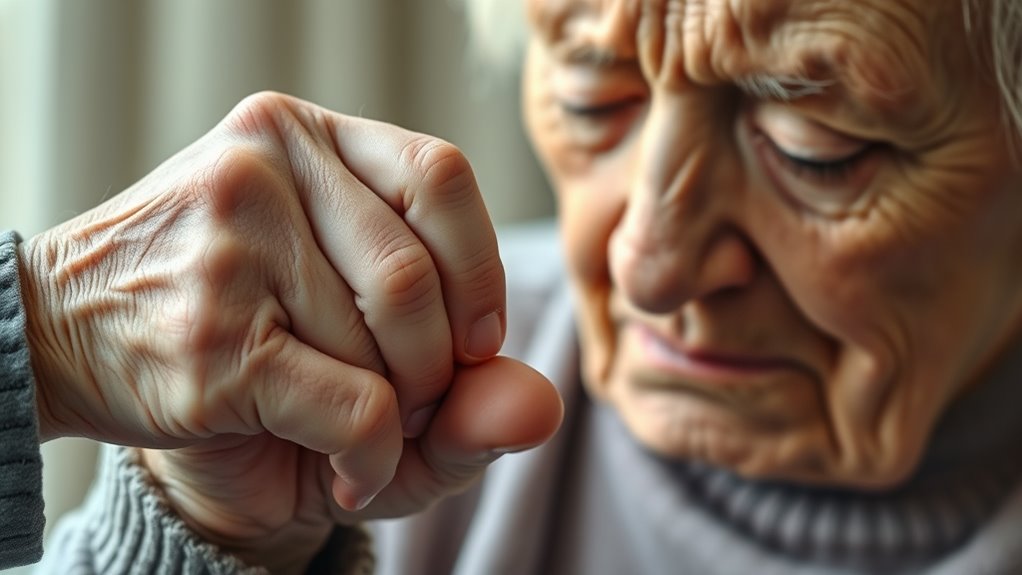When words fail in late-stage Alzheimer’s, you need to watch for subtle signs of discomfort. Look for facial expressions like grimacing or furrowed brows, observe movements such as guarding or withdrawal, and listen for sounds like moans or strained breaths. Changes in activity, agitation, or muscle tension can also signal pain. Recognizing these cues helps you respond appropriately. If you want to learn specific strategies and how to effectively assess pain, stay with us for more insights.
Key Takeaways
- Observe facial expressions such as grimacing, furrowed brows, and clenched jaws for signs of pain.
- Monitor physical movements like guarding, withdrawal, or resistance to movement as behavioral indicators.
- Listen for vocalizations such as moaning, crying, or strained sounds that suggest discomfort.
- Note behavioral changes like agitation, withdrawal, or altered activity levels that may signal pain.
- Use training to recognize subtle cues like tense posture, body language, and eye movements indicative of pain.
Recognizing Nonverbal Indicators of Discomfort

Since verbal communication often becomes limited in late-stage Alzheimer’s, recognizing nonverbal indicators of discomfort is essential. You should pay close attention to facial expressions, such as grimacing, frowning, or clenched jaws, which often signal pain. Changes in posture, like rigid or tense body language, can also indicate distress. Watch for protective movements, such as pulling away or guarding a specific area. Unusual vocalizations, like moaning, groaning, or sighing, may reflect discomfort even if the person can’t speak clearly. Additionally, observe for restlessness, pacing, or agitation, which can be signs of underlying pain. Recognizing these nonverbal communication cues is crucial for timely intervention and comfort. By being attentive to these subtle cues, you can better assess their needs and seek appropriate care, even when verbal expression isn’t possible. Developing a professional demo reel showcasing your ability to interpret such signals can help you connect with caregivers and healthcare providers to improve patient outcomes. Furthermore, understanding the importance of pain assessment tools can aid caregivers in systematically evaluating discomfort levels and ensuring appropriate treatment. Incorporating behavioral observation techniques can enhance your ability to detect changes that indicate pain or distress in nonverbal individuals.
Common Behavioral Changes Signaling Pain

You can often notice pain through changes in facial expressions, like grimacing or frowning. Vocalizations such as moaning or crying also serve as important signals. Additionally, watch for physical movements like restlessness or guarding a specific area, which may indicate discomfort. Using headphones to listen for subtle sounds can sometimes help caregivers detect distress when visual cues are unclear. Being aware of behavioral changes related to pain expression can improve detection and comfort measures. Recognizing behavioral indicators, such as withdrawal or agitation, can further aid in assessing pain levels in non-verbal individuals. Understanding underlying personality traits can help caregivers tailor their responses to individual behaviors, ultimately improving care and comfort. Familiarity with grocery store hours can also assist caregivers in planning visits during times when support services are more accessible.
Facial Expression Clues
Facial expressions can provide essential clues when evaluating pain in individuals with late-stage Alzheimer’s, especially as communication becomes increasingly limited. You might notice a furrowed brow, clenched jaw, or tightened lips, which often indicate discomfort or distress. Look for subtle changes like grimacing or narrowing of the eyes, as these can signal pain even if the person can’t verbalize it. Sometimes, the face may appear tense or frozen in a grimace, reflecting suffering. Pay attention to these nonverbal cues consistently, as they can help you determine when pain is present. Recognizing these facial signs early allows you to intervene promptly, improving comfort and quality of life for those who cannot express their pain through words.
Vocalization Indicators
Vocalization changes are key behavioral signs that can indicate pain in individuals with late-stage Alzheimer’s, especially when verbal communication is limited. You might notice sudden, unusual sounds that weren’t present before, signaling discomfort. These vocal cues can include moaning, groaning, or crying out, often without any apparent reason. The person may also produce sighs or increase their vocal intensity during certain moments. These vocalizations often occur in response to specific stimuli or movement, indicating underlying pain. Recognizing these cues requires close observation and understanding that such sounds are not random but meaningful signals of distress. Being attentive to these vocalization indicators helps you identify pain early and seek appropriate care.
- Sharp, involuntary moans or groans
- Sudden crying or whimpering
- Increased vocalization during movement
Physical Movement Signs
Physical movement changes are often among the earliest signs that someone with late-stage Alzheimer’s is experiencing pain. You might notice them grimacing, flinching, or guarding a particular area. Restlessness or agitation, such as pacing or fidgeting, can also signal discomfort. They may resist movement or become suddenly withdrawn, avoiding activities they once enjoyed. Other signs include facial expressions like clenched jaws or furrowed brows that don’t match their usual demeanor. Changes in muscle tone, such as stiffness or rigidity, may occur. These movements aren’t random; they often reflect an attempt to communicate pain when words can’t. Paying close attention to these behavioral shifts helps you identify pain early and advocate for appropriate care. Recognizing these signs ensures you respond compassionately and effectively to their needs.
Utilizing Pain Assessment Scales for Non-Communicative Patients

Since patients with advanced Alzheimer’s often lose the ability to communicate their pain, healthcare providers must rely on specific assessment tools to detect discomfort accurately. Pain assessment scales help you interpret subtle signs indicating distress. These tools typically involve observing facial expressions, body language, and physiological responses. Using these scales, you can identify pain even when patients can’t verbalize it. Imagine watching for a furrowed brow or clenched fists—small cues that reveal suffering. Visual cues like grimacing or guarding affected areas become essential indicators. Physiological signs, such as increased heart rate or sweating, also provide clues. Incorporating non-verbal communication techniques allows for a more comprehensive understanding of the patient’s experience. By systematically applying these scales, you can better understand your patient’s pain levels, ensuring they receive appropriate care despite their inability to communicate verbally.
The Role of Observation and Caregiver Input

Because patients with late-stage Alzheimer’s often cannot communicate their pain, observation and caregiver input become crucial in evaluating their discomfort. You need to pay close attention to changes in their behavior, facial expressions, and body language. For example, grimacing, moaning, or restless movements can signal pain. Caregivers who spend daily time with the patient can notice subtle signs that others might overlook. Documenting these behaviors helps create a clearer picture of the patient’s pain levels. Additionally, environmental factors, such as positioning or recent procedures, might influence their reactions. Accurate observation and detailed caregiver input are essential for guiding effective pain management when verbal communication isn’t possible. Utilizing vetted tools designed for non-verbal pain assessment can improve accuracy. Being aware of behavioral cues and how they relate to discomfort allows caregivers to respond more effectively. Recognizing pain indicators through careful observation can help prevent unnecessary suffering. Incorporating consistent monitoring can further ensure that pain is identified promptly and managed appropriately. Regular training on behavioral assessment methods enhances caregivers’ ability to detect subtle signs of pain. By being attentive, you ensure the patient’s needs are recognized and addressed promptly.
Physical Signs That May Indicate Pain

Recognizing physical signs that may indicate pain is crucial when communicating with late-stage Alzheimer’s patients is essential, as they may not be able to express discomfort verbally. You should watch for subtle cues that reveal distress, such as changes in behavior or physical appearance. These signs can include restlessness, grimacing, or protective postures. Additionally, shifts in activity levels—either withdrawal or increased agitation—can suggest pain. Being attentive to these cues helps you respond promptly and provide relief. You might notice clenched fists or furrowed brows that signal discomfort. Furthermore, body language can be a powerful indicator of pain and distress in non-verbal patients. It is also important to consider non-verbal communication cues such as eye movements or body language that might indicate pain. Recognizing these signs ensures compassionate, timely care and alleviates unnecessary suffering. Incorporating AI-powered data analytics can assist caregivers in identifying subtle physical indicators of pain more accurately and consistently, especially as advances in AI in Healthcare continue to evolve and enhance patient monitoring. Additionally, understanding behavioral changes can provide further insight into a patient’s pain levels when physical cues are ambiguous.
Challenges in Differentiating Pain From Other Conditions

Identifying pain in late-stage Alzheimer’s patients becomes complicated because many physical signs overlap with symptoms of other medical conditions or age-related changes. For example, restlessness might indicate pain but can also result from anxiety, medication side effects, or neurological decline. Similarly, changes in appetite or sleep patterns may stem from infections, metabolic issues, or depression, not just pain. This overlap makes it difficult to distinguish whether observed behaviors are caused by discomfort or other underlying issues. You need to be cautious, as misinterpreting these signs can lead to under- or over-treatment. Recognizing the subtle differences requires careful observation and a thorough understanding of the patient’s overall health, medical history, and typical behavior patterns. Additionally, understanding electric power generation with bike generators can provide insights into alternative energy sources that might be relevant in healthcare settings or for patient care environments. Exploring patient monitoring tools that utilize advanced sensors can enhance the ability to detect pain-related behaviors more accurately. Implementing sensor technology can help differentiate pain from other causes by providing continuous, objective data that supports clinical assessments. Incorporating innovative assessment methods can further improve accuracy in identifying pain, especially when traditional communication is compromised in late-stage Alzheimer’s. Moreover, integrating real-time data analysis can facilitate quicker responses to patient needs, ultimately improving care outcomes. This complexity emphasizes the need for holistic assessment tools.
Strategies for Effective Pain Management in Advanced Alzheimer’s

To manage pain effectively in advanced Alzheimer’s, you need to recognize nonverbal cues like facial expressions, body movements, and vocalizations. Using tailored interventions guarantees each person’s unique needs are met, reducing discomfort and distress. By focusing on these strategies, you can improve quality of life for your loved one.
Nonverbal Communication Cues
When verbal communication becomes difficult for individuals with advanced Alzheimer’s, nonverbal cues become essential indicators of pain. You might notice sudden facial grimaces, clenched fists, or restless movements that signal discomfort. Changes in posture, such as arching the back or pulling away, can also reveal distress. Additionally, you may observe shifts in activity levels, like increased agitation or withdrawal, as signs of pain. Paying close attention to these cues helps you interpret their needs more accurately. Visualize a person wincing when touched or frowning when trying to move. Maybe they resist being touched or become more agitated when in certain positions. Recognizing these nonverbal signals allows you to respond promptly and provide relief, even when words are not an option.
Tailored Pain Interventions
Effective pain management in advanced Alzheimer’s relies on implementing tailored interventions that address each individual’s unique needs and responses. You should assess how your loved one reacts to different approaches, adjusting treatments as needed. Non-drug strategies like gentle massage, positioning, and soothing activities can reduce discomfort without side effects. When medication is necessary, start with low doses and closely monitor effects, always considering their specific health conditions. Use nonverbal cues and pain assessment tools to guide your choices, ensuring interventions are appropriate and effective. Regularly reevaluate pain levels and responses, adapting your approach over time. Personalizing care not only alleviates suffering but also enhances comfort and quality of life for those with late-stage Alzheimer’s.
Training Caregivers to Detect Subtle Pain Cues

Training caregivers to recognize subtle pain cues is essential because individuals with late-stage Alzheimer’s often cannot verbally communicate their discomfort. You need to pay close attention to small, non-verbal signs that signal pain. These cues can include fleeting facial expressions, sudden changes in posture, or unusual vocalizations. By honing your observation skills, you can better identify when your loved one is in pain, even if they can’t tell you directly.
Observing subtle, non-verbal pain signals helps caregivers provide better comfort for loved ones with Alzheimer’s.
Some cues to watch for include:
- A furrowed brow or clenched jaw appearing unexpectedly
- Shifts in body position, such as pulling away or guarding a specific area
- Short, strained sounds or sighs during routine movements
Recognizing these signs helps you respond promptly, ensuring comfort and proper care.
Frequently Asked Questions
How Can Technology Assist in Pain Detection for Non-Communicative Patients?
You want to know how technology can help detect pain in patients who can’t communicate. Devices like facial recognition software analyze expressions for signs of discomfort, while wearable sensors monitor essential signs such as heart rate and blood pressure for changes indicating pain. These tools give you real-time insights, enabling earlier intervention and better care. By using technology, you can better understand and address your patients’ needs even when words can’t express their pain.
Are There Cultural Factors Influencing Pain Expression in Alzheimer’S Patients?
You should consider how cultural factors shape how Alzheimer’s patients express pain. Different backgrounds influence whether they show discomfort openly or suppress it. Some cultures view showing pain as a sign of weakness, while others encourage expressing feelings. Recognizing these differences helps you interpret their signals accurately, ensuring you provide appropriate care. Being aware of cultural nuances allows you to better assess pain, especially when words aren’t available to communicate effectively.
What Legal Considerations Exist Around Pain Management in Advanced Dementia?
You need to understand that legal considerations for pain management in advanced dementia include ensuring informed consent, documenting treatments carefully, and following regulations about administering medications. You must also be aware of potential abuse or neglect concerns and adhere to protocols that protect patient rights. Staying updated on local laws and institutional policies helps you provide ethical, legal, and compassionate care while managing pain effectively.
How Does Pain Assessment Differ Across Various Stages of Alzheimer’S?
Think of pain assessment like steering through a maze, changing as the journey progresses. In early Alzheimer’s, you rely on patient self-reporting, like reading a map. As the disease advances, you shift to observing behaviors—facial expressions, body language—like following subtle clues. In late stages, you become a detective, interpreting silent signals, ensuring you catch pain’s quiet message even when words can’t be spoken.
Can Artificial Intelligence Improve Accuracy in Pain Detection for Non-Verbal Patients?
You might wonder if artificial intelligence can help you better detect pain when patients can’t speak. AI tools analyze facial expressions, body movements, and physiological signals to identify discomfort more accurately. By monitoring subtle cues that humans might miss, AI supports timely intervention. This technology enhances your ability to assess pain, especially in non-verbal patients, leading to more effective care and improved comfort for those with advanced conditions.
Conclusion
Think of caring for someone with late-stage Alzheimer’s as tending a delicate garden. You may not see the flowers’ colors or hear their gentle whispers, but with attentive observation, you notice the subtle signs of discomfort hiding among the leaves. By learning to read these quiet cues, you become the gardener who nurtures their comfort and peace. Your vigilance helps the garden flourish, ensuring your loved one’s final chapters are filled with dignity and gentle care.









